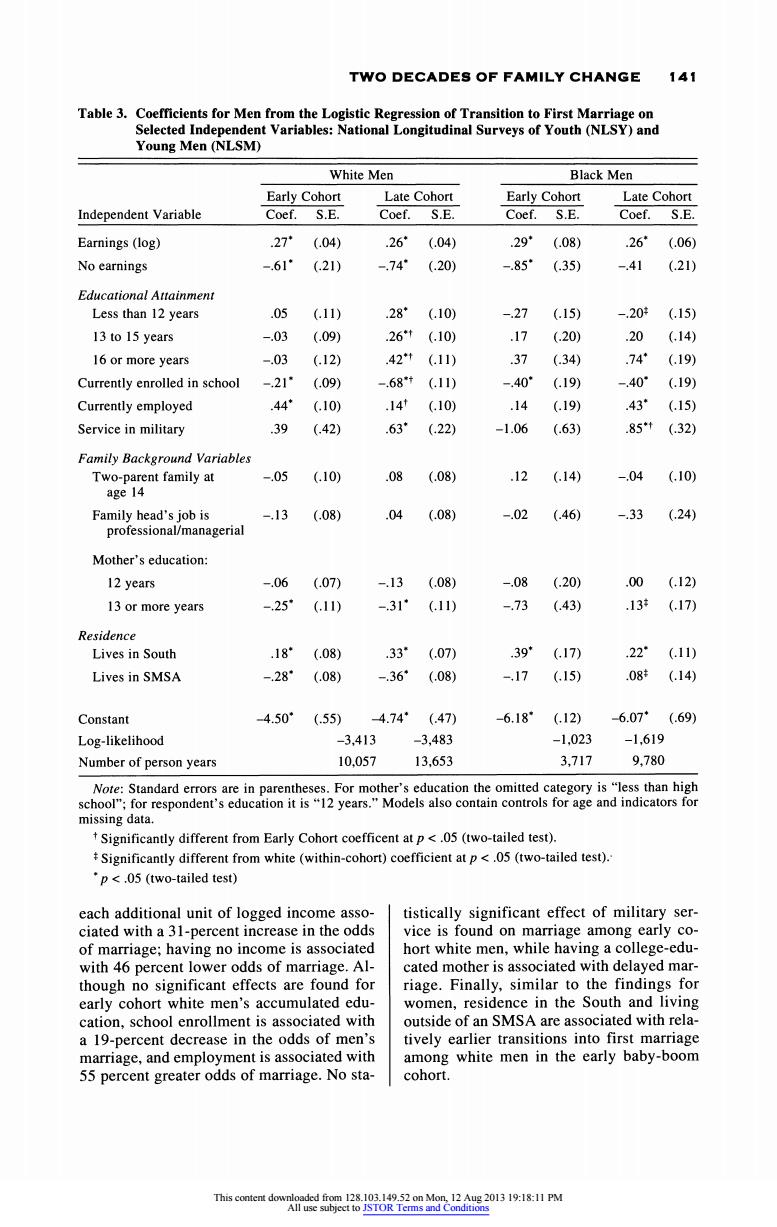正在加载图片...

TWO DECADES OF FAMILY CHANGE 141 Table 3.Coefficients for Men from the Logistic Regression of Transition to First Marriage on Selected Independent Variables:National Longitudinal Surveys of Youth(NLSY)and Young Men (NLSM) White Men Black Men Early Cohort Late Cohort Early Cohort Late Cohort Independent Variable Coef.S.E. Coef.S.E. Coef.S.E. Coef.S.E. Earnings(log) .27 (.04) .26 (.04) 29 (.08) .26 (.06) No earnings -61* (.21) -74 (.20) -.85 (.35) -.41 (.21) Educational Attainment Less than 12 years .05 (.11) 28* (.10) -.27 (.15) -20¥ (.15) 13 to 15 years -.03 (.09) .26*+(.10) .17 (.20) .20 (14) 16 or more years -.03 (.12) .42+(.11) .37 (.34) .74 (.19) Currently enrolled in school -21" (.09) -.68*+(.11) -.40° (.19) -.40 (.19) Currently employed 44* (.10) .14t (.10) .14 (.19) .43 (.15) Service in military 39 (.42) .63 (.22) -1.06 (.63) .85+(32) Family Background Variables Two-parent family at -05 (.10) .08 (.08) .12 (.14) -04 (.10) age 14 Family head's job is -13 (.08) .04 (.08) -.02 (.46) -.33 (.24) professional/managerial Mother's education: 12 years -.06 (.07) -.13 (.08) -.08 (.20) 00 (.12) 13 or more years -25 (.11) -.31 (.11) -.73 (.43) .13t (.17) Residence Lives in South .18 (.08) 33 (.07) 39 (.17) .22 (.11) Lives in SMSA -.28* (.08) -.36 (.08) -,17 (.15) .08t (.14) Constant -4.50 (.55) -4.74 (.47) 6.18 (.12) -6.07 (.69) Log-likelihood -3.413 -3.483 -1,023 -1.619 Number of person years 10.057 13.653 3,717 9,780 Note:Standard errors are in parentheses.For mother's education the omitted category is "less than high school";for respondent's education it is"12 years."Models also contain controls for age and indicators for missing data. t Significantly different from Early Cohort coefficent at p<05(two-tailed test). Significantly different from white(within-cohort)coefficient at p<.05(two-tailed test). 'p<.05(two-tailed test) each additional unit of logged income asso- tistically significant effect of military ser- ciated with a 31-percent increase in the odds vice is found on marriage among early co- of marriage;having no income is associated hort white men,while having a college-edu- with 46 percent lower odds of marriage.Al- cated mother is associated with delayed mar- though no significant effects are found for riage.Finally,similar to the findings for early cohort white men's accumulated edu- women,residence in the South and living cation,school enrollment is associated with outside of an SMSA are associated with rela- a 19-percent decrease in the odds of men's tively earlier transitions into first marriage marriage,and employment is associated with among white men in the early baby-boom 55 percent greater odds of marriage.No sta- cohort. This content downloaded from 128.103.149.52 on Mon,12 Aug 2013 19:18:11 PM All use subject to JSTOR Terms and ConditionsTWO DECADES OF FAMILY CHANGE 141 Table 3. Coefficients for Men from the Logistic Regression of Transition to First Marriage on Selected Independent Variables: National Longitudinal Surveys of Youth (NLSY) and Young Men (NLSM) White Men Black Men Early Cohort Late Cohort Early Cohort Late Cohort Independent Variable Coef. S.E. Coef. S.E. Coef. S.E. Coef. S.E. Earnings (log) .27* (.04) .26* (.04) .29* (.08) .26* (.06) No earnings -.61 * (.21) -.74* (.20) -.85* (.35) -.41 (.21) Educational Attainment Less than 12 years .05 (.11) .28* (.10) -.27 (.15) -.20t (.15) 13 to 15 years -.03 (.09) .26*t (.10) .17 (.20) .20 (.14) 16 or more years -.03 (.12) .42*t (.11) .37 (.34) .74* (.19) Currently enrolled in school -.21* (.09) -.68*t (.11) -.40* (.19) _.40* (.19) Currently employed .44* (.10) .14t (.10) .14 (.19) .43* (.15) Service in military .39 (.42) .63* (.22) -1.06 (.63) 85*t (.32) Family Background Variables Two-parent family at -.05 (.10) .08 (.08) .12 (.14) -.04 (.10) age 14 Family head's job is -.13 (.08) .04 (.08) -.02 (.46) -.33 (.24) professional/managerial Mother's education: 12 years -.06 (.07) -.13 (.08) -.08 (.20) .00 (.12) 13 or more years -.25* (.11) -.31* (.11) -.73 (.43) .13t (.17) Residence Lives in South .18* (.08) .33* (.07) .39* (.17) .22* (.11) Lives in SMSA -.28* (.08) -.36* (.08) -.17 (.15) .08t (.14) Constant -4.50* (.55) -4.74* (.47) -6.18* (.12) -6.07* (.69) Log-likelihood -3,413 -3,483 -1,023 -1,619 Number of person years 10,057 13,653 3,717 9,780 Note: Standard errors are in parentheses. For mother's education the omitted category is "less than high school"; for respondent's education it is "12 years." Models also contain controls for age and indicators for missing data. t Significantly different from Early Cohort coefficent at p < .05 (two-tailed test). t Significantly different from white (within-cohort) coefficient at p < .05 (two-tailed test). *p < .05 (two-tailed test) each additional unit of logged income associated with a 31-percent increase in the odds of marriage; having no income is associated with 46 percent lower odds of marriage. Although no significant effects are found for early cohort white men's accumulated education, school enrollment is associated with a 19-percent decrease in the odds of men's marriage, and employment is associated with 55 percent greater odds of marriage. No statistically significant effect of military service is found on marriage among early cohort white men, while having a college-educated mother is associated with delayed marriage. Finally, similar to the findings for women, residence in the South and living outside of an SMSA are associated with relatively earlier transitions into first marriage among white men in the early baby-boom cohort. This content downloaded from 128.103.149.52 on Mon, 12 Aug 2013 19:18:11 PM All use subject to JSTOR Terms and Conditions